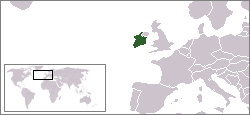Ireland
Ireland (Irish: Éire), also known as the Republic of Ireland (Irish: Poblacht na hÉireann), has a rich culture that, along with its people, has been exported around the world.
Ireland, in fact, has two cultures: the historical Gaelic culture (including one of the oldest literatures in Western Europe) and the more recent English-speaking culture which largely replaced it. It can be worth your while to dig a little deeper before visiting Ireland to discover something about the older world that lies beneath. It is a world still living, though not always visible.
Some Irish history has been very dark indeed, but it remains a land of poets, story-tellers, and musicians, with marvellous scenery, an advanced knowledge economy, first-rate infrastructures, and leading industries, with a high gross domestic product and standard of living.
Regions
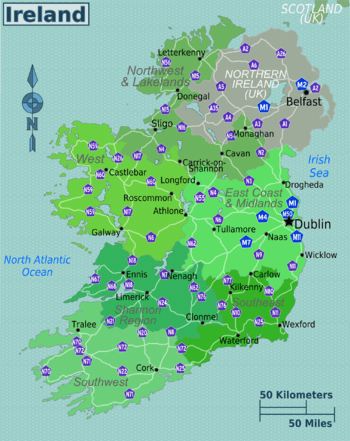
| East Coast and Midlands (County Dublin, County Kildare, County Laois, County Longford, County Louth, County Meath, County Offaly, County Westmeath, County Wicklow) The Irish heartland, home to the capital and vibrant metropolis of Dublin. |
| Shannon Region (County Clare, County Limerick, County Tipperary) A region often visited for its castles and the awe-inspiring Cliffs of Moher. |
| Southwest Ireland (County Cork, County Kerry) A scenic and rainy section of Ireland with a beautiful coast and popular Ring of Kerry and Blarney Castle. |
| West Ireland (County Galway, County Mayo, County Roscommon) Ireland's least populous region, home to the Irish "Cultural Capital" of Galway and the beautiful Aran Islands. |
| Northwest Ireland and Lakelands (County Cavan, County Donegal, County Leitrim, County Monaghan, County Sligo) A region that is growing in tourism activity and has a lot to offer by way of natural beauty. |
| Southeast Ireland (County Carlow, County Kilkenny, County Waterford, County Wexford) A rather cosmopolitan section of Ireland, famous for its Waterford crystal. |
Northern Ireland, a home nation of the United Kingdom, is covered in its own separate article.
Cities and towns
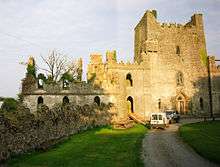
For cities in Northern Ireland, see the separate article.
- 🌍 Dublin (Baile Átha Cliath) — the capital and largest city in Ireland. With excellent pubs, fine architecture and good shopping, Dublin is a very popular tourist destination and is the fourth most visited European capital.
- 🌍 Cork (Corcaigh) — the country's second biggest city — on the banks of the River Lee. Founded c.600 by St Finbarre and known for great food (especially seafood), pubs, shopping and festivals. If you venture outside of the city along the coastline which borders the Atlantic Ocean, you will find long windy beaches, beautiful villages with history, castles and an array of outdoor activities to enjoy.
- 🌍 Galway (Gaillimh) — a city on the river Corrib on the west coast of Ireland. Famous for its festivals and its location on Galway Bay. Known as the City of Tribes, Galway's summer is filled with festivals of music, food, Irish language and culture. Galway hosts over fifty festivals a year, including the Galway Oyster Festival. The locals seem to give off a positive Bohemian vibe. Galway is split between two types of beautiful landscape: the gorgeous mountains to the west, and the east's farming valleys.
- 🌍 Killarney (Cill Áirne)— Possibly, the most popular tourist destination in Ireland. A pleasant town in its own right, it is also the start of most Ring of Kerry trips.
- 🌍 Kilkenny (Cill Chainnigh) — attractive medieval town, known as the Marble City — home to the Cat Laughs Comedy Festival, held annually in early June.
- 🌍 Letterkenny (Leitir Ceanainn) — Main town in County Donegal, designated gateway status and reputed to be the fastest growing town in Europe. Good base for travelling in Donegal.
- 🌍 Limerick (Luimneach) — a city strategically sited where the river Shannon broadens into its mighty estuary in the south-west of the country. First city to receive the designation of National City of Culture (2014).
- 🌍 Sligo (Sligeach) — Home to W.B. Yeats, internationally renowned poet. Mountains and beaches, scenery in general are the best points of Sligo.
- 🌍 Waterford (Port Láirge) — Ireland's oldest city. In the south-east and close to the ferry port at Rosslare. Waterford is a popular visit for those who want to learn more about the most ancient history of Ireland. It is quite possibly one of the best cities in the country as it is not too large and is full of history. Many festivals take place throughout the year including Spraoi. The food is good and the Granary Museum is the best for ancient Irish history in the country. Don't forget to try a blaa before you leave (a floury bread bun peculiar to this area of Ireland).
Other destinations
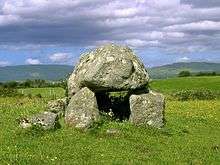
For other destinations in Northern Ireland such as the Giant's Causeway, see the separate article.
- 🌍 Aran Islands (Oileáin Árann) — in Galway Bay
- 🌍 Brú Na Bóinne — in Co. Meath are some of the finest neolithic monuments in the world, the oldest of which is Newgrange, dating back to 3100 BC.
- 🌍 Burren (Boirinn) and the 🌍 Cliffs of Moher (Aillte an Mhothair) — both in the County Clare
- 🌍 Connemara (Conamara) — an Irish speaking region in Western County Galway
- 🌍 County Donegal (Contae Dhún na nGall) — the coastal regions of this county have spectacular scenery and excellent beaches
- 🌍 Dingle Peninsula (Corca Dhuibhne) — a Gaeltecht region (Irish-speaking district) in the very South West corner of Ireland
- 🌍 Glendalough (Gleann Dá Loch) — fine ruins and hiking trails in Co. Wicklow
- 🌍 Kinsale (Cionn tSáile) — gastronomic excellence in Ireland's oldest town
- 🌍 Ring of Kerry and 🌍 Skellig Michael — (Sceilg Mhichíl) in County Kerry
- 🌍 West Cork (Iarthar Chorcaí) — mountains, coves, islands and beaches at the very south of the country
Understand
History
The earliest evidence of human presence in Ireland goes back to 10,500 BCE, when the country was inhabited by a handful of hunter gatherers. Some time before 4000 BCE they were followed by Neolithic settlers, who had migrated northwards along the European coastline from Spain. They brought farming with them and a liking for large stone monuments. They established some of the earliest field systems known in Europe, preserved until the 20th century under layers of peat.
The Bronze Age – marked by skilful metalworking – began in Ireland around 2500 BCE. During the Iron Age (beginning c. 800 BCE) a Celtic language and culture emerged in Ireland, possibly as a result of cultural diffusion from Britain, since there is no archaeological evidence of a Celtic "invasion".
Ireland was Christianised from the 5th century onward, and this brought with it literacy and a knowledge of Latin culture. Monastic towns were established, becoming centres of learning and literature. The monks were the first to commit Ireland’s legends to writing, and composed exquisite nature poetry. The monasteries were a prime target for the Norsemen who invaded in the late 8th century and eventually established important settlements in Dublin, Wexford, Waterford, Cork and Limerick. Local military alliances shifted and melded frequently but monastic Christian culture endured and sent successful missionaries to Scotland, England and as far afield as Switzerland.
The Normans invaded in the early 12th century and set in place Ireland's uneasy position within England's sphere of influence. The Gaelic Ireland they entered had a distinctive society which tended to assimilate newcomers linguistically and culturally. An intensively cultivated classical tradition had developed in the Irish language, producing a unique literature which was matched by a rich folk culture. The Normans had brought English-speaking followers with them, but English for a long time remained marginal.
Irish lords retained a great deal of practical independence until the end of the Elizabethan period. The English Crown, in the person of Elizabeth I, made a determined attempt to impose its own power towards the end of the 16th century, with resistance being led by powerful northern lords, especially Red Hugh O'Neill. Their defeat meant the gradually replacement of the native elite by English landlords.
Irish society and culture were most severely disrupted during the Cromwellian period in the 17th century, when native leaders tried to re-establish Irish independence but were weakened by internal dissension. Despite this, Irish language and culture remained strong, with the 18th century seeing a literary flowering. General adoption of the English language did not occur until the second half of the 19th century, largely as a consequence of bilingualism.
The Act of Union that came into force on 1 January 1801 — in which Catholics, 90% of the Irish population, were excluded from Parliament — saw Ireland joining the United Kingdom. While Great Britain was the cradle of the Industrial Revolution in the 18th and 19th centuries, Ireland remained a farming country; millions of Irish emigrated to Britain, North America and Australia, where the men often worked as labourers and the women as domestic servants. Initially, they often spoke little English.
Irish nationalism remained strong in the 19th century, often expressed through English. Much attention was drawn to the evils of landlordism, exacerbated by the Great Famine of the 1840s, which left many dead and caused a wave of emigration. At the end of the century there occurred the Gaelic Revival, with influential urban intellectuals insisting on the need to modernise and extend Gaelic culture as a basic principle of Irish nationality. Some of them were later at the fore of armed resistance to British rule. The Catholic Church, which had suffered various degrees of persecution from the 16th century on, had now been reorganised and strengthened. It became a potent element in Irish nationalism and a symbol for many of Irish identity, though its influence was to wane in the later 20th century.
By 1900 institutions of British origin were firmly established in Ireland. English was the language of the vast majority but had a strongly native flavour; this made itself felt in a literature which was to become world famous. Irish was still cultivated by a small minority and produced a distinguished modern literature of its own.
Some bars to non-Anglican civic participation had been removed in the 1820s, but in the latter half of the 19th century and early 20th century the subject of Irish home rule was a major debate within the British parliament. After several failed attempts, a Home Rule bill finally passed through parliament in 1914 although the start of the first world war saw its indefinite postponement. A failed rebellion on Easter Monday in 1916 showed a hint of things to come with years of war to follow, beginning with the Irish War of Independence (1919-1921) and continuing with the Irish Civil War (1922-1923).
Eventually a somewhat stable situation emerged with the independence of 26 of Ireland's counties known as the Irish Free State; the remaining six, in the north-east of the country and comprising two-thirds of the ancient province of Ulster, remained part of the United Kingdom — a status that has continued to the present day. In 1949 the Irish Free State became "Ireland" (also known as the Republic of Ireland) and withdrew from the British Commonwealth.
Ireland's history post-partition has been marked to some extent by violence. A a period known as "The Troubles", generally regarded as beginning in the late 1960s, saw large scale confrontation between opposing paramilitary groups seeking to either keep Northern Ireland as part of the United Kingdom or bring it into the Republic. The Troubles saw many ups and downs in intensity of fighting and on occasion were even responsible for terrorist attacks in Britain and continental Europe. The governments of both the UK and the Republic were opposed to all terrorist groups. A peace settlement known as the Good Friday Agreement was finally approved in 1998 and is being implemented. All signs point to this agreement holding steady.
Though a relatively poor country for much of the 20th century, Ireland joined the European Community in 1973 (at the same time as the United Kingdom). Between the mid 1990s and 2008, Ireland had a massive economic boom (and was called "The Celtic Tiger"), becoming one of the richest countries in Europe. However, the global banking crisis and subsequent recession hit Ireland hard, with high levels of unemployment and emigration. The economy is now recovering and many emigrants are returning.
Republic of Ireland and Northern Ireland
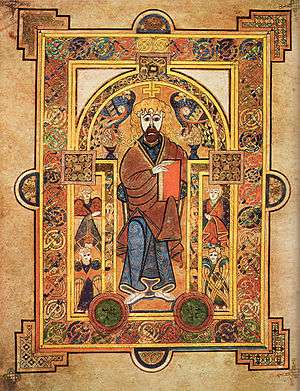
Historically, the island of Ireland consisted of 32 counties, of which six, collectively known as Northern Ireland, have remained as part of the United Kingdom since the rest of Ireland gained independence in 1922. The geographical term "Ireland" applies to the island as a whole, but in English is also the official name of the independent state (i.e. the 26 counties which are not part of the United Kingdom), since 1937. To distinguish the country from the island as a whole, sometimes the description Republic of Ireland (Irish: Poblacht na hÉireann) is used. As part of the Good Friday agreement between the Irish and British governments, all Northern Irish citizens are entitled to dual British and Irish citizenship, just as they are entitled to choose to be only British or only Irish citizens.
However, apart from changes to the road surface and road signs, you probably won't notice much of a difference when actually crossing the convoluted and often obscure international boundary between the six counties of Northern Ireland and the Republic of Ireland. One key difference, though, is that road signs in Northern Ireland are in miles, while those in the Republic of Ireland are in kilometres. Spot checks excepted, there are no formal border markings or controls.
The currency in the Republic of Ireland is Euro and the currency in Northern Ireland as part of the UK is the UK pound so be sure to exchange your euro into pounds before crossing the border.
Climate
Overall, Ireland has a mild but changeable oceanic climate with few extremes. In Ireland you may indeed experience 'four seasons in one day', so pack accordingly and keep up-to-date with the latest weather forecast. No matter the weather, expect it to be a topic of conversation amongst the locals.
You may notice slight differences in temperature between the north and south of the country, and more rain in the west compared with the east.
Mean daily winter temperatures vary from 4 °C to 7 °C, and mean daily summer temperatures vary from 14.5 °C to 16 °C. Temperatures will rarely exceed 25 °C and will rarely fall below -5 °C.
Regardless of when you visit Ireland, even in middle of the summer, you will more than likely experience rain, so if you intend being outdoors, a waterproof coat is recommended.
Get in
If travelling with a pet, check the rules. Some diseases common on the European mainland are absent from Ireland.
Visa requirements
Ireland is a member of the European Union, but not a member of the Schengen Area. Therefore, separate immigration controls are maintained. The following rules generally apply:
- Citizens of EU and EEA countries (and Switzerland) only require a valid national identity card or passport and do not require a visa for entry or employment; in many cases, they hold unlimited rights to employment and residence in Ireland.
- Citizens of Andorra, Antigua and Barbuda, Argentina, Australia, the Bahamas, Barbados, Belize, Bolivia, Botswana, Brazil, Brunei, Canada, Chile, Costa Rica, Croatia, Dominica, El Salvador, Eswatini, Fiji, Grenada, Guatemala, Guyana, Honduras, Hong Kong SAR, Israel, Japan, Kiribati, Lesotho, Macao SAR, Malawi, Malaysia, the Maldives, Mauritius, Mexico, Monaco, Nauru, New Zealand, Nicaragua, Panama, Paraguay, St. Kitts and Nevis, St. Lucia, St. Vincent and the Grenadines, Samoa, San Marino, the Seychelles, Singapore, the Solomon Islands, South Africa, South Korea, Taiwan, Tonga, Trinidad & Tobago, Tuvalu, the United States, Uruguay, Vanuatu, the Vatican City and Venezuela, plus British Nationals (Overseas), require valid passports for entry, but they do not need visas for stays not exceeding three months. The period of admission is determined by the Immigration Officer at the port of entry, but can be extended up to the full 90 days if required. Foreigners who enter without a visa can also extend this stay after entry, but within the initial period of admission and with a valid purpose. Longer stays, employment and citizens of other countries normally require advance visas.
- Citizens of other countries should check the visas lists at the Irish Dept. of Foreign Affairs. The visa application process for tourist visas is reasonably straightforward and is detailed on the Irish Naturalisation and Immigration Service website. Stays based on tourist visas cannot be extended past 90 days under any circumstances.
- Because of an informal agreement between Guernsey, the Isle of Man, Jersey, Sark, the United Kingdom and Ireland, known as The Common Travel Area, there are no passport controls for citizens of these countries travelling to Ireland from any of these countries. On arriving in an Irish airport from the UK, however, you will be asked for valid official photo-identification such as a passport or driving licence which shows your nationality. This is to prove you are entitled to avail of the Common Travel Area arrangements. Immigration controls are mandatory on all inbound flights, selective on ferries, and very occasional at the land border crossings.
|
The Common Travel Area and you If you cross into Ireland by land after arriving in the United Kingdom and being stamped to enter the UK, you will go through passport control at your port of entry into the UK, but you likely will not be required to clear Irish immigration controls, and your authorised stay will generally be under the conditions of your admission to the UK. If you are transiting to Ireland through the UK, however, you will be required to clear passport control in the UK, even if travelling by air. Even if you clear immigration in Ireland, however, after arriving from the UK, this does not count as interrupting your stay in the UK and, accordingly, time spent in Ireland will count against the time you were admitted to the UK. If you intend to travel to the UK from Ireland, even in transit, you will clear passport control in Ireland, but you will not go through immigration on arrival in the UK. However, your stay will be limited to a maximum of three months, not six. If you intend to stay in the UK for longer than three months, especially as a student visitor in the UK, you must apply to extend your stay in the UK (approximately GBP500), obtain a visa for the UK in advance, go to mainland Europe and re-enter the UK, or avoid a transit through Ireland. However, if you require a visa for either Ireland or the UK, you must possess a visa from each country that requires you to have one if you intend to visit both of them. Not passing through passport control does not exempt one from having a visa if needed, and you can be fined and deported for not having a visa if discovered. |
By plane
Ireland is served by 4 international airports, Dublin (DUB IATA), Shannon (SNN IATA) in County Clare, Cork (ORK IATA) and Ireland West, Knock (NOC IATA) in County Mayo. Dublin, the 8th largest airport in Europe, is by far the largest and most connected airport, with flights to many cities in the US, Canada, the UK, continental Europe and the Middle East. Shannon, close to the city of Limerick, also has flights to the US, Canada, Middle East, the UK and Europe. Cork has flights to most UK destinations and a wide variety of European cities. It is easily accessed from any of the major European hubs, including all of the London airports. Knock Airport has daily scheduled flights to several UK cities, as well as various chartered flights to (mostly) holiday destinations in Europe.
Smaller regional airports that operate domestic and UK services include Donegal (CFN IATA), Kerry (KIR IATA), Sligo (SXL IATA) and Waterford (WAT IATA).
The City of Derry Airport (LDY IATA), and both Belfast airports (both the City BHD IATA and International BFS IATA) are within a relatively short distance from the North/South border, especially the former. (These three airports being w in Northern Ireland.)
Ireland's two major airlines are flag carrier Aer Lingus and low-cost carrier Ryanair. Both airlines charge passengers for every extra airport check-in (Ryanair only), checking in baggage, food on board, etc. for short-haul flights, though long-haul flights on Aer Lingus tend to come with more frills. Comprehensive listings of airlines flying directly into Ireland, along with destinations and timetables, can be found on the Dublin, Shannon, Cork and Knock airport websites.
By train
The only cross-border train is the Enterprise service jointly run by Irish Rail and Northern Ireland Railways from Belfast Central to Dublin Connolly.
A Rail-Sail Scheme is also available, linking Stena Line or Irish Ferries with train connections in Great Britain and Ireland. They mainly operate from UK cities across the various Irish and British Rail networks via the Cairnryan-Belfast, Holyhead-Dublin, Fishguard-Rosslare and Pembroke-Rosslare sailing routes.
By bus
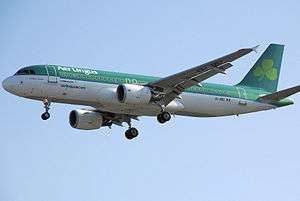
Cross border services are operated by Ulsterbus and Bus Éireann, and various privately-owned companies servicing County Donegal.
Eurolines operate services to Great Britain and beyond in conjunction with Bus Éireann and National Express (Great Britain). Bus Éireann also operates frequent services to and from Eastern Europe, in particular Poland, Lithuania, Latvia and Estonia.
By boat
Ireland is served by numerous services from Great Britain and France:
- Irish Ferries travel from Holyhead (North Wales) to Dublin, and from Pembroke (South Wales) to Rosslare.
- Stena Line connects Holyhead to Dublin.
- Irish Ferries and Brittany Ferries provide services from France (Cherbourg and Roscoff) to Dublin, Rosslare and Cork. Irish Ferries is sometimes significantly cheaper than Brittany Ferries, so compare prices.
- P&O Ferries — Liverpool to Dublin
- Steam Packet Company — services from north-west England (mainly Liverpool) to Dublin, and Isle of Man to Dublin.
- Celtic Link Ferries operate the route from Rosslare to Cherbourg, which was previously run by P&O Irish Sea.
All of the above departure ports are close to railway stations served by National Rail in the UK and SNCF in France. Both Dublin and Rosslare ports have nearby stations served by Iarnród Éireann.
Numerous companies act as agents for the various ferry companies, allowing the comparison of various companies and routes. Three well known brands are Ferryonline, AFerry and FerrySavers.
From Great Britain and Northern Ireland
Due to Ireland's long relationship with the UK, there are no permanent passport controls at the land border. In fact, the border is rarely marked by signs and it's often difficult to tell when you have crossed from the Republic into Northern Ireland and vice-versa. The most obvious signal is that the road signs on the Republic side are mostly bilingual, in Irish and English, and speed limits and distances are shown in kilometres. You may also notice changes in lines in the road; yellow thick lines in the south and white thin lines in Northern Ireland. EEA and Swiss nationals do not need passports for travel between the two, but still need to prove both their identity and nationality if stopped for a spot check; all other foreign nationals need a passport. When arriving at an Irish airport from Great Britain, you will be required to produce photo ID (driving licence or passport) to prove that you are a British or Irish citizen.
However, despite the lack of border controls, be keenly aware that you must possess a valid Irish visa if required for your nationality, or you risk being deported.
If you are flying with Ryanair into Ireland from the UK you must be in possession of a passport or equivalent national identity card. Ryanair will not accept a driver's licence although Irish Immigration (GNIB) do.
Get around
By car
 Crossroads
Crossroads Pedestrian crossing
Pedestrian crossing Turn Left
Turn Left Motorway
Motorway Stop
Stop.svg.png) Yield
Yield No overtaking
No overtaking No parking
No parking Speed limit
Speed limit
There are many car hire companies in Ireland and you can pick up in the cities or at the airports, though it may cost more to pick up at an airport. Most Irish car hire agencies will not accept third party collision damage insurance coverage (for example with a credit card) when you rent a car.
There are a large number of roundabouts in Ireland. Traffic already on the roundabout has right of way over traffic entering it, in contrast to 'traffic circles' sometimes employed in the US.
Caravanning
Holidaying using your own wheels is a popular and very enjoyable experience in Ireland. As the weather can change very rapidly, having the benefit of shelter whilst you drive caught on quickly in this corner of Europe. Caravan parks are generally available reasonably close to all tourist attractions. However, many caravan parks are only open during the main tourist season, usually considered to be between the beginning of April and the end of September. Overnighting at the side of the road or other locations that are not caravan parks is generally not tolerated and many locations are signposted to show any relevant by-laws preventing any overnight camping or caravanning. It is worth doing some planning before travelling with a caravan, as many of the non-main roads are not well suited to campervans or caravans due to the narrowness and general condition of these small roads. Main roads and national routes are however well suited to these vehicles. There is a list of approved caravan parks listed on the Camping-Ireland website.
Taxis
Taxis in Ireland will have green and blue decals on both the driver and passenger doors containing the word "TAXI", the taxi license number and the transport for Ireland logo. These decals are being phased in since January 2013 and not all taxis will have them yet.
It is highly recommended that you call ahead to book a taxi. The hotel, hostel, or bed and breakfast you are staying in will usually call the cab company they work closely with for your convenience. Taxis should be reasonably easy to pick up on the streets in Dublin, Belfast and Cork but may be harder to find cruising the streets in smaller cities and towns so it is often best to telephone for one. It is recommended to call the cab company in advance if possible and give them a time to be picked up, no matter if it's 4 hours in advance or 30 minutes in advance. Work with the same cab company your hotel does and let them know your final destination if there is more than one stop. You will also need to give them a contact phone number over the phone, so if calling from a pay phone, be prepared for them to deny your claim for a taxi cab. The average waiting time may be anywhere from 5 to 30 minutes depending on demand and time of day. All taxis in the Republic of Ireland operate on a National Fare basis, so the price should be relatively easy to calculate. For more information, see the Commission of Taxi Regulation website. Always ensure that the taxi you use has a meter, and that it is used for the duration of your journey.
Rules of the road and road user etiquette
The rules of the road in Ireland are similar to those of the United Kingdom: drive on the left and yield to the right at a roundabout. The most noticeable difference is the fact that distances and speed limits are displayed in kilometres in the Republic. This can be confusing to anyone travelling across the border from Northern Ireland, which, like the rest of the UK, uses miles and miles per hour. The legal blood-alcohol limit is low (though one of the highest by European standards), so it may be best to abstain. It is perfectly legal to temporarily use the hard shoulder to allow a faster moving vehicle to overtake you, but remember that this manoeuvre is not allowed on a motorway.
Drivers often 'thank' each other by flashing their hazard lights or waving, but this is purely a convention. In smaller towns and villages, vehicles will often slow or stop to allow other road users and pedestrians to cross or otherwise maneuvre on the road. Again this is a convention based on Irish cordiality rather than a legal requirement. Road signs in the Republic are nominally bilingual, with place names displayed in Irish in italics, with the corresponding English name in capitals immediately below. In the Gaeltacht (Irish-speaking) areas, road signs are written in Irish only.
There are four types of road classification in Ireland. They are:
| Sign | Sign Colour | Prefix | Class | Max Speed Limit | Notes |
|---|---|---|---|---|---|
| White on blue | M | Motorways |  |
||
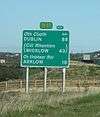 |
White/yellow on green | N | National routes |  |
|
 |
Black on white | R | Regional roads |  |
|
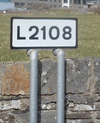 |
Black on white | L | Local roads |  |
Rarely marked, although signage is improving. |
Speed limits are defaults for the road classification only — if a different speed limit is signed, it must be obeyed. Urban areas generally have a 50 km/h speed limit.
Ireland has an extensive motorway network centred on Dublin. Most motorways in the Republic have some tolled sections. Tolls are low by French or Italian standards, and vary from €1.40 (M3) to €3.10 (M50), depending on which motorway you are travelling on. Tolls are displayed a few kilometres from the plaza. The only tolled road that accepts credit cards is the M4 between Kilcock and Kinnegad. All others (except the M50) are Euro cash only, so take care if you're arriving from the North via the M1. The M50 is barrier free and accepts no cash. Cameras are on overhead gantries between Junctions 6 & 7 which read your number plate. If you have registered before online or by phone €2.60 will be taken from your credit card. If you have not registered, you must go to a Payzone branded outlet and pay the toll there. This option costs €3.10.
The main motorways are as below (with toll charges being relevant for private cars only):
| Motorway | Route | Toll |
|---|---|---|
| Dublin to Northern Ireland, towards Belfast | Drogheda bypass section, €1.90 | |
| Dublin to Ashbourne, towards Derry | None | |
| Dublin to Cavan | Entire route, 2 tolls each of €1.40 | |
| Dublin to Mullingar, towards Sligo | Kilcock to Kinnegad section, €2.90 | |
| Junction 11 with the M4 to Galway, although there is a gap in the middle which is only a dual carriageway | Between junction 15 (Ballinasloe West) and junction 16 (Loughrea), €1.90 | |
| Dublin to Limerick | Portlaoise to Castletown section, €1.90 | |
| Junction 19 with the M7 to Cork | Fermoy bypass section, €1.90 | |
| Junction 11 with the M7 to Waterford | None | |
| Dublin to Wexford along the east coast | None | |
| Junction 18 with the M6 to Tuam | None | |
| Limerick to Galway | None | |
| Limerick towards Cork; only a small section near Limerick has been built | None | |
| Dublin Port to Shankill, bypassing Dublin City by going in an orbital ring around. |
|
There are numerous routes of high quality dual carriageway, which are very near motorway standard; Dublin-Wicklow, Sligo-Collooney (Sligo), Mullingar-Athlone, and Cork-Middleton (Waterford).
Lesser roads are in many parts poorly signposted, the only indication of what route to take often being a finger-sign at the junction itself. The road surfaces can be very poor on the lesser used R & L numbered routes.
Driving on regional and local roads in Ireland requires etiquette, courtesy and nerves of steel. Roads are generally narrow with little to no shoulder or room for error. Sight lines can be limited or non-existent until you are partway into the road. Caution should be taken when entering onto the roadway as well as when driving along it, with the understanding that around the next turn may be another motorist partway into the road. This is especially true in rural areas. Parking along the road, farm animals, as well as large lorries or machinery may also appear around the bend and be the cause for quick thinking or braking. It is not unusual for oncoming cars to navigate to a wide spot in the road to pass each other. On the other hand, when driving slower than following cars, it is common for drivers to allow others to pass or signal if the way is clear. Calculating driving time can be slower than expectations, due to the large increase in motorists and road conditions/hazards.
Speed limits

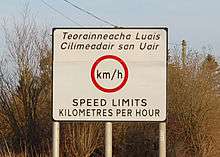
As mentioned above, speed limits in Ireland are in kilometres per hour. When crossing the border from Northern Ireland into into the Republic of Ireland, on main roads, you can expect to see a large sign announcing that speed limits are given in kilometres per hour and all speed limit signs have the text "km/h" on them to remind drivers. Northern Ireland, as well as the rest of the UK has speed limits in miles per hour.
Local Councils may apply other limits in specific areas as required. Also, when roads are being maintained or worked upon in some way, the limit may be temporarily changed.
Car rental companies
Car hire companies are plentiful, with all major airports and cities well catered for. The ports of Rosslare and Dún Laoghaire are served by Hertz and Dan Dooley respectively. As elsewhere, the main driver needs a credit card in their own name and a full driver's licence for a minimum of two years without endorsement. Most rental companies apply a minimum age of 25; many require you be 28 to rent a full-size car. Rentals include minimum insurance which covers the car, leaving a deductible owed in the case of an accident. At additional cost, Super Damage Waiver (SDW) can reduce this deductible to zero.
If renting a vehicle registered before 2008, the car may have a speedometer in miles per hour, as kilometres per hour were only introduced in Ireland in 2008.
Quite a number of companies offer campervans for hire.
By plane
With improvements to the motorway network, domestic flights in Ireland have been reduced drastically, and are now only from Dublin to Kerry and Donegal.
By train
- See also: Rail travel in Ireland
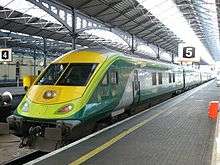
With the exception of the Enterprise service to Belfast, all trains in Ireland are operated by the state-run [http://www.irishrail.ie Irish Rail, usually known by its Irish name, Iarnród Éireann. Most trains run to and from Dublin. Enormous expenditure on modernising the state-owned Irish Rail system is ongoing, including the introduction of many new trains. The frequency and speed of services is being considerably increased, especially on the Dublin-Cork line. If you book on-line for Intercity travel, be aware that there may be a cheaper fare option available to you at the office in the station itself. Not all special rates, e.g. for families, are available on line. The Irish network is less dense than elsewhere in Europe, and speeds are slower, with few lines being electrified, but where trains do go, they are a good option.
Advance booking can result in big savings and booking can be made a month in advance, e.g. an adult return between Kerry and Dublin can cost €75 if booked for the next day but can cost as little as €20 - 30 if booked well in advance. Trains nearly always book out for major sporting events in Dublin such as the GAA Semi-finals and Finals and major rugby and football Internationals. Pay notice to this if planning to travel on weekends during August and September. The 1st and 3rd Sunday of September see both All-Ireland finals held and buses and trains see a massive upsurge in travel as well as the main roads to the counties participating.
There are two main stations in Dublin - Connolly Station (for trains to Belfast, Sligo and Rosslare) and Heuston Station (for trains to Cork, Limerick, Ennis, Tralee, Killarney, Galway, Westport, Kilkenny and Waterford.)
In Northern Ireland, almost all services are operated by (Northern Ireland Railways (NIR) the only mainline railway in the United Kingdom not privatized in the 1990s.
In the Dublin city area the electrified DART (acronym for Dublin Area Rapid transit) coastal railway travels from Malahide and the Howth peninsula in the North to Bray and Greystones in Co. Wicklow via Dún Laoghaire and Dublin city centre. An interchange with main line services and the Luas Red line is available at Dublin Connolly.
By tram
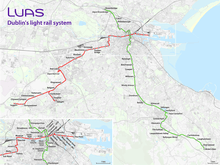
%2C_April_2006.jpg)
Dublin has a tram system known as the Luas (the Irish word for 'speed'). There are two main lines with 54 stations between them. The red-line operates from Dublin's Docklands starting at The Point (beside the O2 Arena) and the city centre (Connolly Station) to a large suburb south-west of the City (Tallaght). The green line runs south-north, via the city centre, from Bride's Glen to Broombridge (where it connects with the Maynooth suburban railway line).
Operation times:
- Monday to Friday — 05:30 to 00:30
- Saturday — 06:15 (Green Line), 06:30 (Red Line) to 00:30
- Sunday — 06:45 to 23:30 (Green Line), 07:00 to 23:30 (Red Line)
- Bank holidays — same as Sundays, except trams run until 00:30
Tickets must be purchased from machines before boarding the tram. Tickets are checked in the Luas at random by inspectors but generally ticketing works on a trust system. Thus free rides are possible, although not advisable, as the fines for fare-dodging can be quite high. The Luas tram provides a very useful link between Dublin's Connolly and Heuston railway stations.
By bus
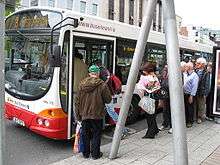
- Bus Éireann (or Irish Bus) operates an extensive intercity network plus local services in major towns. Bus Éireann's website provides various options for buying online bus tickets which offer a good discount compared to buying them at the station or on the bus. Some Bus Éireann buses and stations provide free WiFi.
A number of privately-owned companies also provide intercity services. These include:
- JJ Kavanagh & Sons operate an extensive intercity network directly from Dublin Airport and Shannon Airport to Limerick, Carlow, Waterford, Clonmel, Kilkenny and Dublin city Center plus local services in some towns and cities. Many intercity bus services have free WiFi on board.
- Citylink provides frequent service from Galway to Shannon, Dublin, and Dublin Airport.
- GoBus runs non-stop services between Galway, Dublin + Dublin Airport and Cork.
- Aircoach connects Dublin with Cork and with most major hotels across Dublin on its routes to Leopardstown, Greystones, Dalkey and Ballsbridge.
By boat
- Shannon cruises are a leisurely way of travelling from one town to another. Dromineer and Carrick on Shannon are good bases.
- There are many canals in Ireland, and it is possible to travel by barge on some of them. The Grand and Royal canals are fully navigable from Dublin to the River Shannon, leading to the cities of Limerick and Waterford. Information can be obtained from Waterways Ireland, the managing body for inland waterways.
By bicycle
Ireland is beautiful for biking, but use a good touring bike with solid tyres as road conditions are not always excellent. Biking along the south and west coasts you should be prepared for variable terrain, lots of hills and frequent strong headwinds. There are plenty of camp grounds along the way for long distance cyclists.
The planned Eurovelo cycle route in Ireland will connect Belfast to Dublin via Galway, and Dublin to Rosslare via Galway and Cork. Visit their website for updates on the status of the path.
Dublin has some marked bicycle lanes and a few non-road cycle tracks. Traffic is fairly busy, but a cyclist confident with road cycling in other countries should have no special difficulties (except maybe for getting used to riding on the left). Cyclists have no special right of way over cars, particularly when using shared use paths by the side of a road, but share and get equal priority when in traffic lanes. Helmets are not legally required, but widely available for those who wish to use them. Dublin Bikes has 400 bikes available to the public in around 40 stations across the city centre. The bikes are free to take for the first half hour, although a payment of €150 is required in case of the bike being stolen or damaged. When finished, return the bike back to any station and get your payment refunded.
Talk
- See also: Irish phrasebook, English language varieties
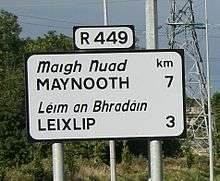
Almost everyone speaks English as their first language, though often in a way that reflects the influence of Irish. Irish or Irish Gaelic (Gaeilge) is the first official language according to the constitution. It belongs to the Goidelic branch of the Celtic family of languages and is strikingly different to English.
The main dialects of Irish are those of the provinces of Ulster, Munster and Connacht (with the last being historically a central dialect which stretched eastwards into Leinster). The Ulster dialect has most in common with Scottish Gaelic. Some Irish people may take offence if you call Irish "Gaelic," as this really refers to an entire branch of the Celtic languages including Irish, Manx, and Scottish Gaelic. Refer to it simply as "Irish" or “the Irish language”.
There are still thousands of fluent Irish speakers, all of them bilingual. Some of them are traditional native speakers in remote (and usually scenic) rural areas known as Gaeltachtaí. They are now outnumbered by urban Irish speakers, who are especially numerous in Dublin, and are often young, middle-class and well educated. Irish speakers are served by a number of radio stations, an online newspaper, numerous blogs and an innovative television station (TG4). They have an impressive modern literature and a popular annual arts festival known as the Oireachtas.
Irish is a compulsory language in mainstream English-speaking schools in the Republic, and is required in order to enter certain Irish universities. About 40% (c. 1,500,000) of people in the Republic claim some knowledge of the language as a result, but the real number of proficient speakers is probably closer to 300,000 (about 7% of the population).
Notwithstanding this, English is the only language you are likely to encounter while travelling in Ireland. This means that visitors are often unaware that habitual Irish speakers can be found throughout the country, with a thriving (though not so obvious) culture of their own. Such speakers usually use English in the presence of strangers, but most Irish people see the language as an integral part of their culture.
As many place names and personal names are in Irish, some knowledge of Irish pronunciation can be useful for foreigners, and even locals who are not fluent in Irish typically know how to pronounce Irish words.
Tourists keen to learn a few words of the Irish language can fall for a prank whereby they are taught to swear while being assured that they are learning a greeting or similar phrase.
Both Irish and English are spoken in Ireland with several different accents, and it is easy to distinguish the accent of someone from Northern Ireland from that of someone from the Republic. You can often even distinguish between different cities within the Republic of Ireland (e.g. Dublin vs Cork). Accents also vary by social class, and in the city of Dublin in particular you will notice distinct upper-class and working-class accents.
It is important to remember that many Irish speak English quite rapidly compared to speakers from the UK or North America. In Ireland some words are different, and may have different meanings. For example, "deadly" in Hiberno-English usually means "cool" or "awesome", (e.g. "That's deadly" means "That's wonderful") instead of "dangerous". Irish loanwords and idioms are also common in Hiberno-English.
In everyday interactions Irish friends and relations engage in a style of conversation surprising (if not alarming) to unprepared tourists. The insult, putdown or sideswipe, known as 'banter,' is a highly nuanced art-form aimed at showing affection. It's all in the timing and tone and not to be attempted unless you are visibly in a good mood. High-spirited and friendly teasing is also known as craic and is generally inseparable from the consumption of alcohol.
See
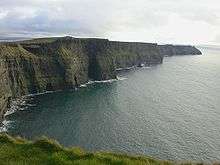
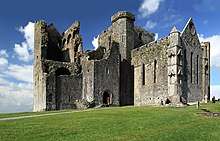
It's more than just a stereotype: Ireland's highlights are indeed the stuff of knights' tales. That's at least true for its myriad of fascinating castles, dramatic cliff shores, lush rolling pastures and rugged hills. Many of the country's main attractions are of a sturdy kind of beauty. There's the megalithic tombs of Brú na Bóinne, older than the Egyptian pyramids and the inspiration for some of the famous Celtic symbols of later times. Of much later date is the beautiful Blarney Castle in County Cork, known for its "Blarney Stone." According to tradition, kissing the Blarney Stone will bless a person with "the gift of the gab", or a remarkable eloquence. Achieving it requires lying back while a castle employee holds you and a photographer captures the moment. Equally interesting is the Rock of Cashel, the remains of a majestic 12th century castle overlooking the green surrounding plains.
The island's rough coast line is one of its main tourist attractions. The stunning 230m high Cliffs of Moher are a spectacular place and the most popular of the cliffs to visit. It's surely among the most dramatic spots, but only one of many scenic parts of the Irish coast. Head to Achill Island to see the Croaghaun, the highest of them all, as well as the lovely Keem Bay and other beaches. Visit the beautiful Aran Islands, where local culture has survived the test of time and green pastures are dotted with castles and churches. Drive the Wild Atlantic Way to take in more of the scenic shores, stopping for breaks in charming coastal towns. More inland there are a number of national parks worth exploring, including the limestone karst landscapes of the rest of the Burren (of which the Cliffs of Moher are part). The vast peatlands of Ballycroy National Park offer another great place for hikes, as do the lakes and forests of Killarney National Park. The pleasant town of Killarney itself is home to Ross Castle but also serves as a popular starting point for the Ring of Kerry.
Kilkenny, an old city which once served as a capital, is easy to reach from Dublin and one of the country's favourite tourist spots. Its beautiful buildings and imposing Norman castle - not to mention the numerous festivals including the Arts Festival and Rhythm and Roots Festival — make Kilkenny a most desirable location. If you have or can rent your own vehicle, explore the amazing area of Co. Donegal. Expect to see plenty of low stone walls, thatched roof houses, rugged hills, cliffs and golden sand beaches in this traditional region. Best visited during Spring or summer, it offers plenty of hill walks and photo opportunities.
Limerick has the majestic King John's Castle, but Cork and Galway also make for popular summer destinations full of lively nightlife and historic heritage. And then... there is of course Dublin. Quintessentially Irish and a fine place to sample the country's famous beer culture, it's also home to some excellent sights. Dublin Castle is a fine choice, and Trinity College has a wonderful library where you can see one of the oldest manuscripts in the world, the Book of Kells. While any sightseeing may be topped off with a pint, many beer lovers do so at the Guinness Storehouse.
Do
Sport
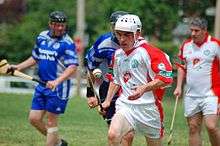
Irish people love their sport. The largest sporting organisation in Ireland, and the largest amateur sporting organisation in the world, is the Gaelic Athletic Association, more commonly referred to as the GAA. The GAA governs Ireland's two national sports which are Gaelic football and hurling.
To those that have never seen it, Gaelic football could at its simplest be described as a cross between soccer and rugby, but there is much more to it than that. Hurling is the fastest field game in the world. If it could be categorised into a group of sports, then it would be closest to the field hockey family, but hurling is unique. No visit to Ireland, especially during the summer months, would be complete without seeing a Gaelic football or hurling match, ideally live but at least on the TV. The biggest matches of the year take place during summer culminating in the two finals which are both in September, on two separate Sundays. The All-Ireland Hurling Final is normally on the first Sunday of September and the All-Ireland Football final is on the third Sunday of September. These are the two largest individual sporting events in Ireland, so tickets are like gold dust. Croke Park, the venue for the two finals, has a capacity of 82,300 people, making it one of the largest stadiums in Europe. Those that can't get tickets will crowd around televisions and radios, and around the world Irish people will be watching or listening to the finals.
While Gaelic Football and Hurling are the two biggest sports, Ireland has much else to offer in terms of sport. Ireland is a world leader in breeding and training race horses. There are many race tracks around the country and many big racing festivals throughout the year.
Golf is another huge sport in Ireland. Ireland has many great professionals, but for the visitor there are many golf courses around the country. Golfing holidays are popular.
Soccer and Rugby are also popular in Ireland. Ireland's rugby team in particular is amongst the best in the world. There are also many soccer clubs around Ireland including Shamrock Rovers, Bohemians, Sligo Rovers, Shelbourne etc., tickets cost as little as €15 for a full match which many home fans will guide you around. Both sports have many competitions.
Being an island, Ireland has many water sports. Sailing is big in Ireland. On the west coast in particular Ireland has very high seas, ideal for surfing, even if the weather isn't always great. Kitesurfing is growing everyday in Ireland, from the East to the West coast. Check Dollymount in Dublin City, Rush, Bettystown, Blackrock/Dundalk on the East Coast and Sligo (Rosses Point), Donegal, and Kerry on the west coast.
Music
Ireland has a bustling scene for folk and popular music; see Music in Britain and Ireland.
Bus tours
For travellers wishing to experience Ireland on a budget, there are a variety of inexpensive bus tours in almost every part of the country. These tours can range from hop-on hop-off busses in major cities such as Dublin and Cork to 5-day trips through some of the most scenic parts of the country. The bus drivers/guides are generally well informed about Irish history and enjoy sharing local legends and songs with anyone happy to 'lend an ear'.
Buy
Money
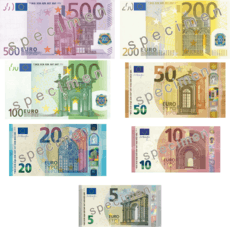
|
Exchange rates for Euros As of 25 January 2019:
Exchange rates fluctuate. Current rates for these and other currencies are available from XE.com |
Despite official European advice to the contrary, in Ireland, the plural of "euro" is also "euro". For instance, €2 is pronounced as 'two euro' not 'two euros'.
Stand-alone cash machines (ATMs) are widely available in every city and town in the country and credit cards are accepted most outlets. Fees are not generally charged by Irish ATMs (but beware that your bank may charge a fee).
Along border areas, as the UK pound sterling is currency in Northern Ireland, it is common for UK pounds to be accepted as payment, with change given in Euro. Some outlets, notably border petrol stations will give change in sterling if requested. (Fuel is now generally cheaper in the South, resulting in many Northern motorists purchasing their fuel South of the border.)
Differences in prices of goods between the Irish Euro and the British Pound have resulted in increasing numbers of Irish shoppers crossing the border to purchase goods which are a lot cheaper in Northern Ireland than in the Republic. A November 2008 article in a Northern newspaper highlighted how up to €350 can be saved by buying your Christmas shopping in Derry and Belfast in the North rather than in the likes of Letterkenny in Donegal.
Only a few years ago when the Celtic Tiger was still very much alive and well the economic situation was reversed.
ATMs
ATMs are widely available throughout Ireland. Even in small towns it is unlikely that you will be unable to find an ATM. Many shops and pubs will have an ATM in store, and unlike the UK, they cost the same to use as 'regular' ATMs on the street. Though in-shop ATMs are slightly more likely to run out of cash and be 'Out of Service'.
Credit cards
MasterCard, Maestro and Visa are accepted virtually everywhere. American Express and Diners Club are now also fairly widely accepted. Discover card is very rarely accepted and it would not be wise to rely on this alone. Most ATMs allow cash withdrawals on major credit cards and internationally branded debit cards.
In common with most of Europe, Ireland uses "chip and PIN" credit cards. Signature-only credit cards, such as those used in the US, should be accepted anywhere a chip and PIN card with the same brand logo is accepted. The staff will have a handheld device and will be expecting to hold the card next to it and then have you input your PIN. Instead, they will need to swipe the card and get your signature on the paper receipt it prints out. Usually this goes smoothly but you may find some staff in areas that serve few foreigners are confused or assume the card cannot be processed without a chip. It is helpful to have cash on hand to avoid unpleasant hassle even in situations where you might have been able to eventually pay by card.
Tipping
Tipping is not a general habit in Ireland. The same general rules apply as in the United Kingdom. It is usually not customary to tip a percentage of the total bill, a few small coins is generally considered quite polite. Like most of Europe it is common to round up to the nearest note, (i.e. paying €30 for a bill of €28).
In restaurants tipping 10-15% is standard and for large groups or special occasions (wedding/anniversary/conference with banquet) tipping becomes part of the exuberance of the overall event and can be higher, indeed substantial. Tipping is not expected in bars or pubs and unnecessary in the rare bar or 'Superpub' that has toilet attendants. In taxis the fare is rounded off to the next euro for short city wide journeys, however this is more discretionary than in restaurants. In hotels a tip may be added to the bill on check out, however some guests prefer to tip individual waiters or room attendants either directly or leaving a nominal amount in the room.
In all cases, the tip should express satisfaction with the level of service.
Tax-free shopping
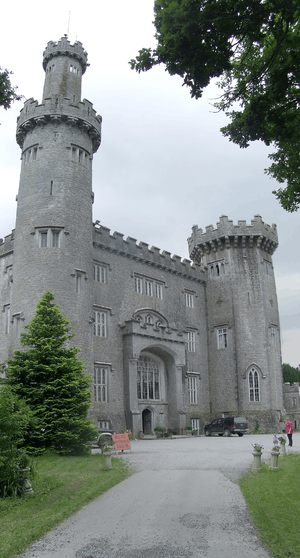
If you are a tourist from a non-EU country, you may be able to receive a partial refund of VAT tax (which is 23%.) However, unlike some other countries, there is no unified scheme under which a tourist can claim this refund back. The method of refund depends solely on the particular retailer and so tourists should ask the retailer before they make a purchase if they wish to receive a VAT refund.
One scheme retailers who are popular with tourists operate is private (i.e. non-governmental) VAT refund agents. Using this scheme, the shopper receives a magnetic stripe card which records the amount of purchases and VAT paid every time a purchase is made and then claims the VAT back at the airport, minus commission to the VAT refund agent, which is often quite substantial. There are multiple such VAT refund agents and so you may need to carry multiple cards and make multiple claims at the airport. However, there may not be a VAT refund agent representative at the airport or specific terminal where you will be departing from, or it may not be open at the time you depart. In which case, getting a refund back could become more cumbersome as you may need to communicate with the VAT refund agent from your home country.
If the retailer does not operate the VAT refund agent scheme, they may tell you that all you have to do is take the receipt they produce to the airport and claim the refund at the VAT refund office at the airport. However, this is incorrect. Irish Revenue does not make any VAT refunds directly to tourists. Tourists are responsible for having receipts stamped by customs, either in Ireland upon departure or at their home country upon arrival and then send these receipts as proof of export directly to the Irish retailer which is obligated to make a VAT refund directly to the tourist. Therefore, for example, if you have made 10 different purchases at 10 different retailers, you will need to make 10 separate claims for refunds with every single retailer. However, some retailers do not participate in the scheme all together and so you may not be able to get any VAT refund from some retailers. Therefore, if you plan on receiving VAT tourist refund on your purchases in Ireland, you should be careful where you shop and which refund scheme they operate, if any.
Further details on VAT tourist refunds can be found in the document Retail Export Scheme (Tax-Free Shopping for Tourists) .
Eat
Food is expensive in Ireland, although quality has improved enormously in the last ten years. Most small towns will have a supermarket and many have a weekly farmers' market. The cheapest option for eating out is either fast food or pubs. Many pubs offer a carvery lunch consisting of roasted meat, vegetables and the ubiquitous potatoes, which is usually good value. Selection for vegetarians is limited outside the main cities. The small town of Kinsale near Cork has become internationally famous for its many excellent restaurants, especially fish restaurants. In the northwest of the country Donegal Town is fast becoming the seafood capital of Ireland.
Cuisine
Traditional Irish cuisine could charitably be described as hearty: many traditional meals involved meat (beef, lamb, and pork), potatoes, and cabbage. Long cooking times were the norm in the past, and spices were limited to salt and pepper. The Irish diet has broadened remarkably in the past fifty years and dining is now very cosmopolitan.
Seafood chowder, Guinness Bread, Oysters, and Boxty vary regionally, and are not common throughout the entire country.
However the days when potatoes were the only thing on the menu are long gone, and modern Irish cuisine emphasizes fresh local ingredients, simply prepared and presented (sometimes with some Mediterranean-style twists). Meat (especially lamb), seafood and dairy produce is mostly of an extremely high quality.
Try some gorgeous brown soda bread, made with buttermilk and leavened with bicarbonate of soda rather than yeast. It is heavy, tasty and almost a meal in itself!
Etiquette
Only basic table manners are considered necessary when eating out, unless you're with company that has a more specific definition of what is appropriate. As a general rule, so long as you don't make a show of yourself by disturbing other diners there's little else to worry about. It's common to see other customers using their mobile phones — this sometimes attracts the odd frown or two but goes largely ignored. If you do need to take a call, keep it short and try not to raise your voice. The only other issue to be concerned about is noise — a baby crying might be forgivable if it's resolved fairly quickly, a contingent of adults laughing very loudly every couple of minutes or continuously talking out loud may attract negative attention. However, these rules are largely ignored in fast-food restaurants, pubs and some more informal restaurants.
Finishing your meal
At restaurants with table service, some diners might expect the bill to be presented automatically after the last course, but in Ireland it seems to be the custom that you must affirmatively ask for it to be delivered. Usually coffee and tea are offered at the end of the meal when removing dishes, and if you don't want any, the best response would be "No thank you, just the bill, please." Otherwise the staff will assume you wish to linger until you specifically hail them and ask for the bill.
Drink
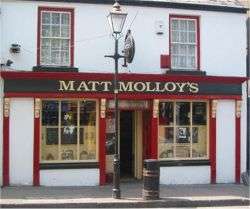
Beer
Pints (just over half a litre) of Guinness start at around €4.20 per pint, and can get as high as €7.00 in tourist hotspots in Dublin.
One of Ireland's most famous exports is stout: a dark, creamy beer, the most popular being Guinness which is brewed in Dublin. Murphy's and Beamish stout are brewed in Cork and available mainly in the south of the country. Murphy's is slightly sweeter and creamier-tasting than Guinness, while Beamish, although lighter, has a subtle, almost burnt, taste. Opting for a Beamish or Murphy's while in Cork is sure to be a conversation starter and likely the start of a long conversation if you say you prefer it to Guinness.
Several micro-breweries are now producing their own interesting varieties of stout, including O'Hara's in Carlow, the Porter House in Dublin and the Franciscan Well Brewery in Cork. Ales such as Smithwick's are also popular, particularly in rural areas. Bulmers Cider (known outside the Republic as 'Magners Cider') is also a popular and widely available Irish drink. It is brewed in Clonmel, Co. Tipperary.
Pubs
Nearly all pubs in Ireland are 'free houses', i.e. they can sell drink from any brewery and are not tied to one brewery (unlike the UK). You can get the same brands of drink in all pubs in Ireland across the country.
Alongside the indigenous beers and spirits of Ireland, many bars, particularly in tourist areas, will carry a selection of the most popular international brands (Budweiser, Heineken, Tuborg) as well as a selection of 'world beers' such as Belgium's Duval, Italy's Peroni, America's Sam Adams, Australia's Coopers and a selection of Eastern European beers such as Tyskie, Zywiec, Utenos, Budvar and Staropramen.
Alcohol can be relatively expensive in Ireland, particularly in tourist areas. However local weekly events magazines will carry information on 'Happy Hours' when some bars loss lead with €3 beers or offer two for the price of one. Happy Hours can start as early as 15:00 and go on until 21:00. Some bars may offer pitchers of beer which typically hold just over three pints, for €10-€11.
Bars must serve their last drinks at 23:30 Sunday to Thursday and 00:30 on Friday and Saturday, usually followed by a half hour 'drinking up' time. Nightclubs serve until 02:00.
It is illegal to smoke in all pubs in Ireland. Some pubs have beer gardens, usually a heated outdoor area where smoking is allowed.
Sleep
There are hotels of all standards including some very luxurious. Bed-and-breakfast accommodations are widely available. These are usually very friendly, quite often family-run and good value. There are independent hostels which are marketed as Independent Holiday Hostels of Ireland, which are all tourist board approved. There is also an official youth hostel association, An Óige (Irish for The Youth). These hostels are often in remote and beautiful places, designed mainly for the outdoors. There are official campsites although fewer than many countries (given the climate). Wild camping is tolerated but try and seek permission—especially where you'll be visible from the landowner's house. Never camp in a field in which livestock are present. There are also specialist places to stay such as lighthouses, castles and ring forts.
Learn
|
Some Useful Irish Phrases:
|
It is fun to learn a few phrases of Irish, but it is unnecessary, as everyone speaks English. Visitors who want to learn Irish can take advantage of language courses specifically designed for them. The best known are provided by Oideas Gael in Donegal and the Gaelic League (Conradh na Gaeilge), which is based in Dublin. They employ experienced teachers whose aim is to equip you with basic fluency and give you an introduction to the culture. You will often find yourself sitting with people from a surprising variety of countries - perhaps as far away as Japan. Even a short course can reveal aspects of Ireland which more casual tourists may miss. But you are strongly advised to check the dates and book beforehand.
Work
Ireland is part of the European Union/European Economic Area and, as such, any EU/EEA/Swiss national has an automatic right to take up employment in Ireland. Non EU/EEA citizens will generally require a work permit and visa. Further information can be found on Citizens Information, the Irish government's public services information website.
Stay safe
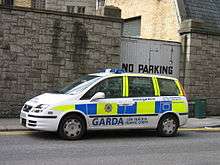
|
☎ Are you in crisis? Samaritans is a free and confidential nationwide 24 hour telephone hotline for people in emotional distress. The concept is simple: you talk, they listen. Please don't suffer alone; call a Samaritan on 116 123. |
The police force is known as An Garda Síochána, (literally, 'Guards of the Peace'), or just "Garda", and police officers as Garda (singular) and Gardaí (plural, pronounced Gar-dee), though informally the English term Guard(s) is usual. The term police is rarely used, but is of course understood. Regardless of what you call them, they are courteous and approachable. Uniformed members of the Garda Síochána do not carry firearms, but the police in Northern Ireland do. Firearms are, however, carried by detectives and officers assigned to Regional Support Units and the Emergency Response Unit (ERU), a tactical unit similar to SWAT. Police security checks at Shannon Airport can be tough if you are a solo traveller.
Crime is relatively low by most European standards, but not so different in kind from crime in other countries. Late-night streets in larger towns and cities can be dangerous, as anywhere. Don't walk alone after sunset in deserted areas in Dublin or Cork, and be sure to plan getting back home, preferably in a taxi. Fortunately, most violent crime is drink- or drug-related, so simply avoiding the visibly inebriated can keep you out of most potential difficulties. If you need Gardaí, ambulance, fire service, coast guard or mountain rescue dial 999 or 112 as the emergency number; both work from landlines/house phones and mobile/cell phones.
In the unlikely event that you are confronted by a thief, be aware that Irish criminals in general are not afraid to resort to violence. Surrender any valuables they ask for and do not resist, as hooligans are bound to have sharp or blunt weapons with them. If you are the victim of a crime, report it immediately. CCTV camera coverage in towns and cities is quite extensive, and a timely phone call could help retrieve your lost belongings.
Many roads in the country are narrow and winding, and there has been an increase in traffic density. Ireland is improving its roads, but due to financial constraints many potholes do not get mended in a timely manner. If using a rented car, keep your eyes peeled for any dents in the road as even the smallest of them could precipitate a rollover or a collision.
Stay healthy
Water
Tap water is generally drinkable. In some buildings you should avoid drinking water from bathroom sinks, which may be recycled or drawn from cisterns.
Smoking
Almost all enclosed places of work in Ireland, including bars, restaurants, cafés, are designated as smoke-free. Ireland was the first European country to implement the smoking ban in pubs. Rooms in hotels and bed-and-breakfast establishments are not required by law to be smoke-free. Even though they are not obliged to enforce the ban, owners of these establishments can do so if they wish. Most hotels have some bedrooms or floors designated as smoking and some as non-smoking, so you should specify at the time of booking if you have a preference either way. The smoking ban also applies to common areas within buildings. This means for example that corridors, lobby areas and reception areas of buildings such as apartment blocks and hotels are also covered by the law.
Most larger bars and cafés will have a (covered) outdoor smoking area, often with heating. This is a great way to meet up with locals. A new concept called "smirting" has been developed - "smoking" and "flirting". If an outdoor smoking area does not exist, be aware that it is illegal to consume alcohol on the street, so you may have to leave your drink at the bar.
Any person found guilty of breaching the ban on smoking in the workplace may be subject to a fine of up to €3,000.
Respect

Visitors to Ireland will find that the Irish are one of the world's more welcoming nations. When lost, as may often happen, given that the road signs are quite different to those of other countries, ask in a local shop for advice. Let them know where you are trying to go and be as specific as possible. Often the directions are by local landmark, so don't be afraid to ask for very specific directions.
In smaller towns and villages, and especially on a country road, if you walk past somebody it is customary to say hello. They may also ask you "how are you?", or another similar variation. A simple hello or "how are you?" or a simple comment on the weather will suffice!
When driving on rural roads, particularly where a driver has to pull in to allow you to pass, it is customary to wave a thanks to the other driver, by raising your hand from the steering wheel. This also applies when walking, if there are no traffic lights and a driver lets you cross the road.
When accepting gifts, a polite refusal (such as, "no really you shouldn't") is common after the first offer of the item. Usually, this is followed with an insistence that the gift or offer be accepted, at which point a refusal will be taken more seriously. However, some people can be very persuasive — this isn't meant to be overbearing, just courteous.
The Irish usually respond to a "thank you" with "It was nothing" or "not at all" ("Níl a bhuíochas ort" in Irish). This does not mean that they didn't try hard to please; rather, it is meant to suggest "I was happy to do it for you, so it wasn't a problem" (even though it may have been!). This can often also mean that they expect that they can ask for a favour from you at some point or that you are in some way indebted to the person who did something for you. There is a significant amount of "you scratch my back, I'll scratch yours" entrenched in the Irish culture.
Public or semi-public discussions about religious differences, political views and 20th century troubles are generally avoided by locals on both sides of the border. Opinions between individuals are so vastly divided and unyielding, that most Irish people (of moderate views) have grown accustomed to simply avoiding the topics in polite conversation, especially since almost everyone in small towns knows each other well.
The Irish are renowned for their sense of humour, but their humour can be difficult to understand for tourists not familiar with it. The Irish will joke about themselves or other cultures, and may appear to be tolerant of non-nationals joking about the Irish, but beware - it is easy to cause offence!
LGBT visitors will find most Irish people to be accepting of same-sex couples, although overt public displays of affection are rare except in Dublin and (to some extent) in Cork City. Ireland introduced civil partnerships in 2011 and voted to legalise same-sex marriage in 2015. Conservative values can still be found in Ireland, especially with the older generation. As in many other countries, the younger generation are generally more accepting. Ireland has anti-discrimination laws that are predominately for the workplace, though few cases have been brought forward. Common sense should prevail in all areas, and acceptance has become far more widespread. In 2015, opinion polls leading up to the marriage equality referendum repeatedly showed, almost without variation, that about 75% of Irish people supported gay marriage rights.
Connect

Phone numbers in this guide are given in the form that you would dial them from outside Ireland. When using a landline within Ireland, the international dial prefix and country code of +353 should be substituted by a single 0. However, most landlines and mobile phones will accept the prefix 00353 or +353 to call Ireland numbers.
By mobile/cell phone
There are more mobile phones than people in Ireland, and the majority of these are pre-paid. Phone credit is available in very many retailers, usually in denominations from €5 to €40. Be aware that some retailers charge a small commission on this credit, while many others don't, so it does pay to shop around.
All mobile numbers begin with 087, 086, 085, 083 or 089 (this code must be dialled regardless of location or operator of dialler). Mobiles are cheap by European standards to buy, and if staying for more than 2 months, it could be cheaper to buy a phone than phone cards.
A tri- or quad-band GSM phone will work, but you should check that your operator has a roaming agreement. It can be expensive to receive and make phone calls while roaming.
You can also buy a cheap prepay SIM card if you have an unlocked handset. This can be considerably cheaper as it means that you will be assigned an Irish number on which you can be called during your trip, and your outgoing calls are charged at normal Irish mobile rates. If you have a European or American phone, it is likely the charger accepts both 120 V and 240 V power (but be sure to check the rating on the plug or transformer lest you fry it!), but you will still need a cheap plug adapter that you can pick up at many convenience or grocery stores after you arrive, or a department or travel accessory store before you leave, to be on the safe side. (Ireland uses the same voltage and plugs as the United Kingdom; see Electrical systems.)
If you do not have an unlocked tri- or quad-band GSM phone then it is possible to buy a mobile phone in Ireland from any of the cell phone companies. If you need a cell phone number before you travel, you can rent a phone from Rentaphone Ireland.
If you do not have a "chip and PIN" debit card (most U.S. debit and credit cards do not have a chip) and permanent contact information in Ireland (landline, address) then in some cases you may have problems paying for phone service. Having cash on hand in Euros may make this process considerably easier, and you might want to try that first to speed things along.
Phones that have the 1800 MHz band but not 900 MHz will work but coverage is extremely poor outside urban areas.
Ireland has 12 mobile networks as outlined below. The prefix numbers are owned by each network, but can be ported to another network at the customer's request, so that the customer can change network but keep their number.
| Operator | Band | Dialling Prefix | Notes |
|---|---|---|---|
| Three | GSM 900/1800/UMTS 2100 | 083 & 086 | The 086 prefix previously belonged to O2 Ireland. |
| BlueFace | GSM 900/1800/UMTS 2100 | 083 | Uses Three network. |
| Meteor | GSM 900/1800/UMTS 2100 | 085 | |
| eirMobile | GSM 900/1800/UMTS 2100 | 085 | Uses Meteor network |
| Vodafone | GSM 900/1800/UMTS 2100 | 087 | |
| Postfone | GSM 900/1800/UMTS 2100 | 087 | Uses Vodafone Ireland network. |
| Digiweb | - | 088 | |
| Tesco Mobile | GSM 900/1800/UMTS 2100 | 089 2 & 089 4 | Uses Three network. |
| 48 | GSM 900/1800/UMTS 2100 | 089 2 & 089 4 | Uses Three network. |
| Virgin Mobile | GSM 900/1800/UMTS 2100 | 089 60 & 089 61 | Uses Three network. |
| iD Mobile | GSM 900/1800/UMTS 2100 | 089 70 & 089 71 | Uses Three network. |
| Lycamobile | GSM 900/1800/UMTS 2100 | 089 9 | Uses Three network. |
Non-geographic numbers
Non-geographic numbers are those which are not specific to a geographical region and are charged at the same rate regardless of where the caller is located.
| Call type | Description | Dialling Prefix |
|---|---|---|
| Freephone | Free from all phonelines | 1800 |
| Shared Cost (Fixed) | Cost one call unit (generally 6.5 cent) | 1850 |
| Shared Cost (Timed) (also known as Lo-call) |
Cost the price of a local call | 1890 |
| Universal Access | Cost the same as a non-local/trunk dialling call | 0818 |
| Premium Rate | Generally more expensive than other calls | 1520 to 1580 |
Calling home
Pay phones have become quite rare, but they are still available in limited numbers. Most take euro coins, prepaid calling cards and major credit cards. You can also reverse the charges/call collect or use your calling card by following the instructions on the display.
To dial outwith Ireland: 00 + country code + area code + local number. For example, to call a Spanish mobile, it would be 00 34 6 12345678.
To dial Northern Ireland from Ireland a special code exists; drop the 028 area code from the local Northern Ireland and replace it with 048. This is then charged at the cheaper National Irish rate, instead of an international rate. Some providers accept +44 28 as a national rate when calling to Northern Ireland.
To dial an Irish number from within Ireland: Simply dial all of the digits including the area code. You can optionally drop the area code if you're calling from within that area and on a landline phone, but it makes no difference to the cost or routing. The area code is always required for calls from mobiles.
Fixed line numbers have the following area codes:
- 01 (Dublin and parts of surrounding counties)
- 02x (Cork)
- 04xx (parts of Wicklow and North-East Midlands, excluding 048)
- 048 (Northern Ireland)
- 05x (Midlands and South-East)
- 06x (South-West and Mid-West)
- 07x (North-West, excluding 076)
- 076 (VoIP)
- 08x (Pagers and mobile phones)
- 09xx (Midlands and West)
Operator service is unavailable from pay phones or mobile phones.
Emergency services dial 999 or 112 (Pan European code that runs in parallel). This is the equivalent of 911 in the US/Canada and is free from any phone.
Directory information is provided by competing operators through the following codes (call charges vary depending on what they're offering and you'll see 118 codes advertised heavily):
- 118 11 (Eir)
- 118 50 (conduit)
- 118 90
These companies will usually offer call completion, but at a very high price, and all of them will send the number by SMS to your mobile if you're calling from it.
Postal rates
Postal services are provided by An Post. The costs of sending postcards and letters are:
- Inland mail (island of Ireland): €1.00 (up to 100g)
- International mail (all other destinations): €1.50 (up to 100g)
These rates are correct as of April 2018.
